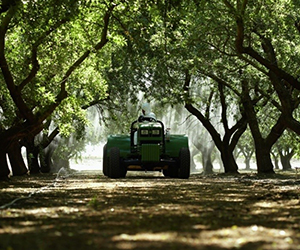With the first flight of navel orangeworm (NOW) upon us and the second flight just around the corner, careful NOW management is critical to yielding a healthy almond crop in 19/20.
 It’s important to drive slowly and give the air from the sprayer time to reach the tree tops. Even a minor change in ground speed can have significant impact on pest control.
It’s important to drive slowly and give the air from the sprayer time to reach the tree tops. Even a minor change in ground speed can have significant impact on pest control.
Thanks to research-backed technologies and practices, growers can make sizable progress toward controlling NOW by implementing proactive management steps throughout the year. Practices such as winter sanitation and mating disruption, for example, enable growers to get a jump on a NOW problem. Still, even with a proper year-round IPM plan, spray applications may be needed to control NOW, especially in orchards with high levels of this pest.
“Regardless of your management with mating disruption and winter sanitation, pesticides still play a role,” said David Haviland, entomologist and farm advisor for the University of California Cooperative Extension in Kern County. Haviland recommends growers work with their PCAs to determine if hullsplit sprays are needed, and to nail down the appropriate timing and number of hullsplit sprays to reduce crop damage due to NOW.
Four application tips for controlling NOW
For effective sprays, growers should keep four key factors in mind as they prepare to make spray applications.
1. Timing: UC Davis recommends growers only deploy spring sprays (late April to mid-May) for NOW if the orchard has a history of high NOW damage and high trap captures. For hullsplit applications, timing should coincide with the beginning of hullsplit and with the beginning of NOW’s second flight. It’s essential that the first hullsplit spray (if multiple are needed) is completed no later than 1% hullsplit.
2. Calibration: It’s important that sprayers are set up properly so that each application reaches the top level of the trees while also minimizing spray drift.
3. Speed: Growers and applicators need to go the proper speed — a recommended two miles per hour — to optimize coverage in the orchard.
4. Spray Volume: Decades of research shows that using 200 gallons per acre, with the rig traveling at the proper speed, will maximize effectiveness of the application.
Research funded by the Almond Board and others shows that proper sprayer speed and spray volume are often overlooked during hullsplit even though the research repeatedly shows that slowing down improves spray coverage. This research should not be overlooked, especially since the focus for hullsplit NOW sprays is to reach the trees’ hard-to-reach nut sutures.
The NOW challenge doesn’t stop after applying pesticides — the objective just shifts to getting ahead of NOW next season. Ultimately, strategic IPM practices all season long are essential in the almond industry’s effort to achieve the Almond Orchard 2025 Goal of increasing the adoption of environmentally friendly pest management tools by 25% by 2025.
To learn more about NOW control using effective IPM, visit the UC IPM webpage dedicated to NOW damage, management and more.